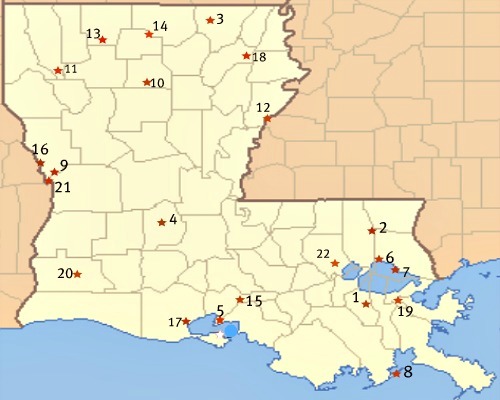Louisiana State Parks
Many Of The Louisiana State Parks Feature The Type Of Swampland That The Region Is Famous For
There are twenty two State Parks in Louisiana which are all operated by the Office Of State Parks, a division of the Louisiana Department of Culture, Recreation and Tourism.
The idea for a system of parks in Louisiana dates back to 1934 but it wasn`t until the following year that the first park was opened, this was the Chemin-A-Haut State Park.
|
To See A List Of The Louisiana State Parks Just Click Here |
Louisiana is a state in the southern part of the United States, its largest city is New Orleans but the capital is Baton Rouge.
Unique among all the American states is the fact that its sub-divisions are not called counties but are known as parishes. |

The Atchafalaya Basin In South Central Louisiana. It Is The Largest Swamp In The United States.
The state has a wonderful multicultural and multilingual heritage that partly comes from it having been a Spanish and French colony. However, Native Americans and African Americans have all added to a society that is considered exceptional within the United States.
Geographically, Louisiana can be divided into two parts. To the north are the uplands and to the south the low swamps and coastal marshes with the barrier islands offshore. The highest point in what is a fairly flat state is Driskill Mountain which is only 535 fet above sea level.
Probably the most important feature in Louisiana is the Mississippi River which runs in a north to south direction for around 600 miles before flowing into the Gulf Of Mexico. The delta of this mighty river contains these lowland swamps and marshes.
 There Were Devastating Floods In New Orleans As A Result Of Hurricane Katrina |
Louisiana can be badly affected by hurricanes, tropical storms and also tornadoes. The flooding that these events bring can sometimes be devastating.
On average Louisiana experiences thunderstorms for more than sixty days every year.
The area had been inhabited by Native Americans for thousands of years before the European explorers arrived. These were the Spanish who first reached the region in 1528. Other Spanish parties followed but their interest in the region soon waned and the French began to arrive during the 17th century. |
Along with their first settlements, the French lay claim to a vast part of the continent, from the border with Canada south to the Gulf Of Mexico, it all became a French colony and was named for King Louis XIV.
However, following the French and Indian War the French territory east of the Mississippi was ceded to Great Britain while much of the rest, excluding the area around New Orleans, became a Spanish colony.
In 1800 the Emperor Napolean regained Louisiana from Spain as the results of a secret treaty but by this time the United States was concerned about a foreign power being on what they considered to be their land.
The 1803 Louisiana Purchase finally gave America title to all the lands once owned by France. This single deal immediately doubled the size of the United States. The purchase price was $15 million which worked out at around three cents an acre!

Fishing On The Reservoir At Jimmie Davis State Park, Louisiana
However, this European influence in Louisiana has remained with the state and the French language is everywhere. It has been reinforced by migrants from many French speaking islands in the Caribbean, especially Haiti.
This French influence is reflected in the names of a number of the Louisiana State Parks, for example there are Chemin-A-Haut State Park, (the name translates as "High Road") Lake D`Arbonne State Park and Lake Bistineau State Park.

The Swamp At Tickfaw State Park
Other Louisiana State Parks are situated around the features that make this state so special. Bayou Segnette State Park has the swamps and marshes of the wetlands, Grand Isle State Park is to be found on the beautiful shores of the Gulf Coast, while one of the latest Louisiana State Parks, Tickfaw State Park has all three of the distinct ecosystems to be found in the state. These are cypress swamp, hardwood forests and pine/hardwood forests.
Here is a list of the Louisiana State Parks
|
|
And this shows their positions on a county map of Louisiana






